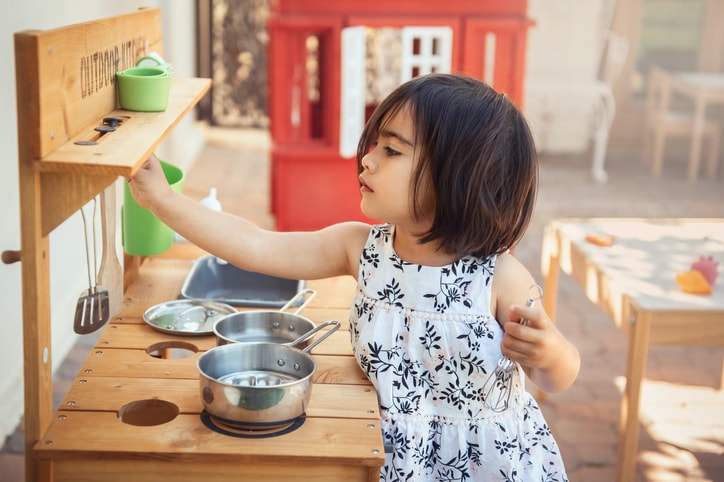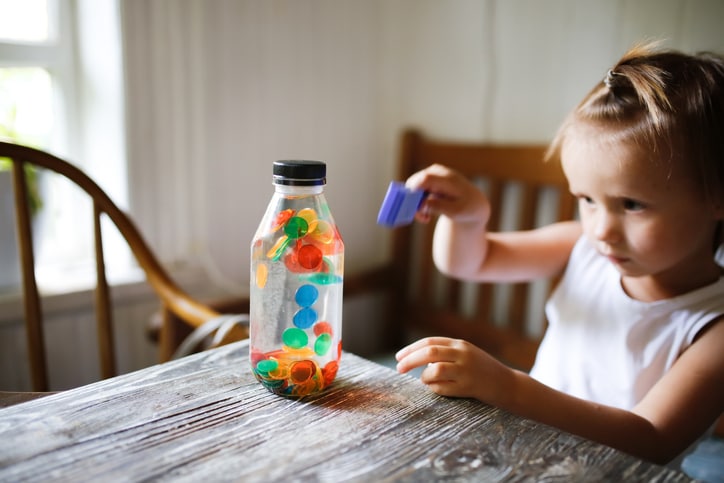Depending on how you were raised, you may have been taught that learning is serious business, and playtime is just for fun, burning off energy or a reward after learning. But over time, science has proved what many parents and educators already knew: Learning through play can actually be more effective — and more enjoyable.
“Through play, children not only have fun but also develop a wide range of cognitive skills that lead to better academic outcomes, social, emotional, and physical skills,” says Iman Alleyne, a teacher and founder of Kind Academy. This play-based, nature-focused, inclusive “microschool” has a campus in South Florida and a virtual option through the online learning platform Outschool.com.
Alleyne started Kind Academy while raising kids. A lifelong teacher, she’d seen the results of play and hands-on learning but couldn’t find an option like this for her kids. So she made one, and she’s seen this approach benefit kids time and time again. “Learning through play is not only fun but also stimulates cognitive development, like language and literacy skills, numeracy and critical thinking,” Alleyne says.
Benefits of learning through play
Suzanne Barchers, a prolific author and teacher who holds a doctorate in education, has observed the vast benefits of learning through play in her personal and professional life. So much so that she’s currently the Education Advisory Board Chair at Lingokids, an app for young kids focusing on learning through play.
Barchers says the importance of play is universal. “Even if you go to the zoo, you’ll see animals that play; they’re solving problems and learning things just like kids do,” she says. Here are just 10 of the nearly countless benefits of learning through play:
1. Aids physical development
From little movements to big ones, play matters. “As young children are manipulating blocks or small toys, they’re developing fine motor coordination with their hands,” Barchers says. “As they’re playing on the playground, they’re developing strength and flexibility.”
2. Encourages creativity
“When kids get the freedom to express themselves, their creativity soars, and they become out-of-the-box thinkers,” Alleyne says, which can result in amazing ideas and solutions that might even impress adults.
“Learning through play is not only fun but also stimulates cognitive development, like language and literacy skills, numeracy and critical thinking.”
— Iman Alleyne, a teacher and founder of Kind Academy
3. Supports mental health
Peter Michael Joseph, a licensed marriage and family therapist in Orange County, California, says kids need to be able to exhaust their energy through movement, and learning through play can accomplish this. “Movement-based therapies help many children experiencing depression and anxiety,” he says. “If you can help the child move through their natural energy, the child will benefit mentally and physically.” He adds that in his own practice, he’s found kids more at ease if they’re walking and moving during a session rather than sitting.
4. Improves socialization
“In the process of playing, especially with other children, this socialization is very critical,” Barchers says. “They’re learning to take turns, work things out and do problem solving.”
Alleyne adds that play can also help kids develop leadership and communication skills, especially when they invent forms of play themselves with peers. “The games they create, the rules they make for fairness, and their conflict resolution abilities are impressive,” she explains.
5. Builds social skills
In addition to enhancing peer socialization, learning through play can teach other social skills that help kids at school and home. For example, Alleyne says, playing a movement-based game like “Red Light, Green Light” or “Freeze Dance” does more than boost coordination. It also helps improve listening skills and ability to follow directions.
Teaches resilience to loss. Barchers often played card games with her young grandchildren; some focused math skills, while others were simple games like Go Fish. It could make her grandkids crazy, but she never just “let them win” since that’s not how life works and it doesn’t build resilience, she explains. “The nice thing about games like that is not only do you learn some new skills, but you also learn to deal with losing the game,” she points out.
6. Fosters bonding and memories
When parents or caregivers play with a child, they deepen bonds and form memories, Barchers says. She reflects on lasting memories created while playing with her grandkids, like when she dropped a key lime pie on the ground that they’d just made together. Not only did this provide a funny memory they still laugh about years later, Barchers says, but it showed how “it’s important to learn to laugh over things and not get upset.” This, she said, also builds resilience.
7. Enhances confidence
Some types of play subtly introduce lessons on setting goals and achieving challenges, Barchers says. She points to playing on monkey bars; kids can set goals, like how many rungs without falling, or how many seconds to hang on. When they challenge themselves and succeed, she notes, they experience a sense of accomplishment. Even when not successful, it demonstrates “even if you fail, you come back and try again,” adds Barchers.
8. Teaches without feeling like learning
What a child might see as skipping a jump rope or kicking a soccer ball might seem like all fun fun. But Barchers says parents can incorporate learning into it, like counting numbers of throws, adding up scores, creating number-based goals, etc.
9. Eases learning for neurodivergent kids
Learning through play can be especially helpful in certain populations, Barchers says. “If you have children on the autism spectrum who are prone to Obsessive Compulsive Disorder or learning in one way, and you introduce other ways to solve problems through play, it’s not as threatening as saying, ‘You need to learn to be able to do this or that,’” This can be especially helpful with developing social skills, Barchers says. Physical skills and play may be harder for some kids, she adds, but with accommodations, persistence and encouragement, it’s a win-win.
“As kids grow older, unstructured playtime lets them unleash their creativity, invent games and collaborate with friends.”
— Iman Alleyne
How can parents incorporate learning through play?
“Learning through play is a magical gateway to unlocking your child’s potential,” Alleyne says. Try these expert tips for putting it into practice at home.
Incorporate play into everyday routines.
Barchers suggests parents introduce play into routine parts of the day; for example, “Bathtime can be mathtime.” She suggests bringing funnels and plastic cups or spoons in the bath, nudging experimentation with filling and emptying. She also encourages including kids in cooking and baking; it teaches basic math like fractions, and it can help you. “Plus, it’s fun for the kids to cook when they’re little; it becomes a chore if they’re not used to it when they’re 16,” she notes.
Don’t overthink it.
Barcher says as a young parent and teacher, she tended to set up distinct play areas, step back and observe. There’s nothing wrong with that, she says, but there doesn’t need to be a formal grocery playset or designated time. Play can mean setting out wax paper and shaving cream for creative play while you’re cooking, she says.
With young kids, even just going outside to dig for worms, or playing simple movement-based games has benefits, points out Alleyne.
Balance structured and unstructured time.
There’s nothing wrong with structured games and activities, but leave time for unstructured play and exploration too. “As kids grow older, unstructured playtime lets them unleash their creativity, invent games and collaborate with friends,” Alleyne says. She suggests encouraging hands-on, unstructured play by leaving out toys like blocks or art supplies.
Let your kid lead the way.
Joseph says parents sometimes try to have the child fill their own criteria, like wanting their kid to play the sport they played and know. Instead, he encourages meeting kids where they are and having conversations to connect and learn from them. “Listen with a genuine attempt to get to know them,” he says. “Ask questions to try to understand them. Parents can impart wisdom by being empathetic, watching them, and moving with the child in directions they choose,” he says.
Look at pictures of yourself and try to remember the freedom and fantasy of childhood, suggests Joseph. Connecting with your own inner child can help you better connect with your child and guide this journey of learning through play, he says.
Set up your home for success.
Alleyne suggests parents set up easy creative activities for when needed, whether homemade, bought or found online. Some of her suggestions:
- Sensory bins: Fill bins with various materials like rice, sand or water and let your kids explore textures and engage in imaginative play.
- Scavenger hunt: Hide clues or objects related to a favorite book around the house or backyard, stimulating problem-solving skills.
- Music sets: “Invest in musical instruments like hand bells and drums,” Alleyne says, which nurtures creativity and develops coordination.”
- Lovevery: Alleyne suggests buying this company’s curated kits, which promote various developmental skills by age through play.
Seek out in-person opportunities.
Alleyne encourages parents not to forget about their local libraries, since they often feature kid classes that promote play and interactive learning. She also suggests finding sensory-based classes, online or in-person.
Learning through play: The bottom line
Whether you grew up being taught the value of play or you were scolded for “wasting time,” it can be hard as an adult to remember how important play is. It can be deceptively simple, but as our experts point out, physical, mental, social and emotional growth happens below the surface.
Play shouldn’t be a reward for learning, like a gold star a child may get for completing their chores. As Alleyne says, “Play is an essential part of childhood and serves as a powerful strategy for learning.”






